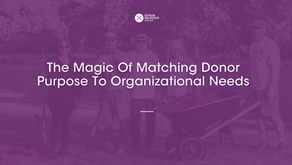How to Use Research In Your Everyday Work
- Lynne Wester
- Oct 21, 2021
- 3 min read

You may already know this about the DRG Group, but we are self-proclaimed lifelong learners, and dare we say it, "data nerds." Every time a new study drops, like the The 2021 Bank of America Study of Philanthropy: Charitable Giving by Affluent Households, you can find us combing through the data searching for nuggets of greatness we can use to inform our work.
In fact, we love data so much we conduct our own biennial survey called the Pulse of Donor Relations. But, more on that in a second.
You see the data, you understand what it says, so now what? How do you apply research studies in your everyday work? We have a few tips:
Use research to advocate for change. Facts do a great job combatting anecdotal evidence that tends to be inaccurate. For example, page 57 of the Bank of America Study shows how donors determine the impact of their giving, this is wonderful data for us in donor relations. The next page identifies reasons why they STOP giving, which is powerful information for us to examine as we think about donor retention. We can do everything in our power in donor relations to help retention, but it's also the asking that greatly affects retention as well! So use these surveys to help your work—it helps combat emotional anecdotal evidence and puts the donors wants and needs at the center of our work! Donors often compare the experiences they receive at different nonprofits, and keeping an eye on where we're headed as a profession can help us stay on the leading edge as practitioners. This approach can be especially persuasive when working with executive leadership, gift officers, and other members of the team who aren't on the front lines of donor relations.
Use research as a tool for benchmarking. Results from research studies like the Pulse are a fantastic tool for benchmarking where your shop is in industry trends and best practices. It's reassuring when some of your department’s efforts are pacing at or above industry average; conversely, it can help you identify where you are lagging (for example, print-only vs digital delivery of reports…pre-ODDER, of course!) and need to modernize or refresh your approach.
Use research for leading-up. Particularly when leadership is new to your organization or perhaps new to Donor Relations. Leadership loves benchmarking—rarely will organizations dip their toes into the water of change without understanding the landscape of their peers and potential success (as proven through case studies) that can be gleaned from professional surveys and benchmarking studies. To be able to show analytics of our industry and to pinpoint where your shop is in terms of industry norms is an excellent way to demonstrate your shop’s strengths and position your weaknesses as areas of opportunity—and of course, advocate for more staff and more resources!
Professional tools and research, like the Pulse of Donor Relations Survey, are helpful resources to keep on hand—especially if you want to evaluate and identify areas for improvement in your donor relations efforts. We look forward to sharing our research with you in early 2022.
Have you participated in the 2021 Pulse survey? If not, please take a few moments to tell us about donor relations at your organization by taking the survey—it closes next week!
We are endlessly grateful for the hundreds of you—our colleagues and friends—who have already participated in this important study. From the bottom of our data-loving hearts, thank you for making this research possible.





